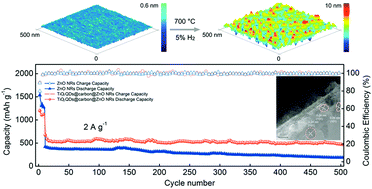Titanicone-derived TiO2 quantum dot@carbon encapsulated ZnO nanorod anodes for stable lithium storage†
Abstract
To address the issues of large volume expansion and low electrical conductivity of ZnO anode nanomaterials during lithium ion battery operation, herein we engineered a rod-like ZnO anode with robust and conductive TiO2 quantum dot (QD)@carbon coating derived from molecular layer deposited titanicone, in which the TiO2 QDs are well confined inside the carbon layer. Transmission electron microscopy (TEM) and X-ray photoelectron spectroscopy (XPS) confirm the formation of TiO2 QDs and carbonization of fumaric acid in hybrid films after annealing in H2 atmosphere at 700 °C. Benefiting from a unique protective layer design, the prepared TiO2 QD@carbon@ZnO nanorod (NR) anodes display outstanding cycling performance with a discharge capacity of 1154 mA h g−1 after 100 cycles and 70% capacity retention, along with a high rate capacity of 470 mA h g−1 for 500 cycles at 2 A g−1. Moreover, our work demonstrates an innovative and promising approach toward a robust and conductive metal oxide QD@carbon nanocomposite layer for electrode materials in the future.



 Please wait while we load your content...
Please wait while we load your content...